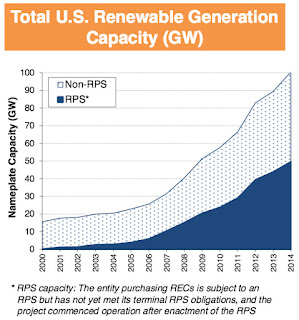In defense of renewable energy mandates.
Back in the 1990s and 2000s, when Democrats had more power in state governments, 29 states (and DC) passed some form of renewable portfolio standard (RPS), a policy that requires a state’s utilities to get a certain percentage of their power from renewable sources by a certain year.
Standards range from California’s wildly ambitious 50-percent-by-2030 to Ohio’s modest 12.5-percent-by-2026, and everywhere in between.
Though they aren’t as sexy as perpetually-discussed-but-rarely-passed carbon taxes, and they are flawed and insufficient in a number of ways, RPSs have been the quiet workhorses of renewable energy deployment in the US. According to one Lawrence Berkeley Lab report, fully 62 percent of the growth in US non-hydro renewables since 2000 has been undertaken to satisfy RPS requirements.
Consequently, there’s been a great deal of research done about their various costs, benefits, and impacts. One thing that’s been missing, however, is a comprehensive prospective analysis, projecting the total costs and benefits of RPSs going forward.
Happily, such an analysis was published in September in the journal Environmental Research Letters.
If you’ve followed previous research literature on RPSs (and who hasn’t?), the top-line results probably won’t surprise you. Spoiler: The benefits of these policies will substantially outweigh the costs, even under conservative assumptions.
Aside from the basic finding, I do think the results can shed light on two important points — one important to the future of the US grid, one important to politics and policy making in general. And y’all know how I love to make points.
Read more at The Most Effective Clean Energy Policy Gets the Least Love

No comments:
Post a Comment